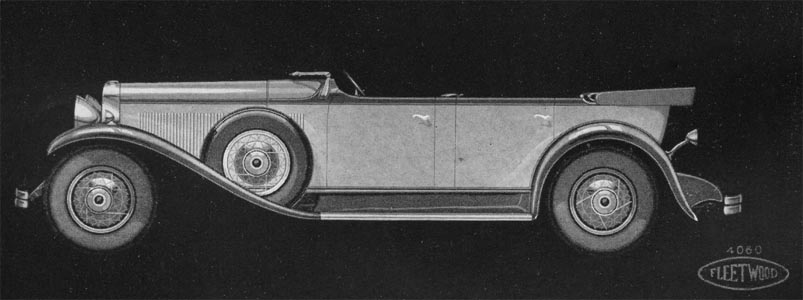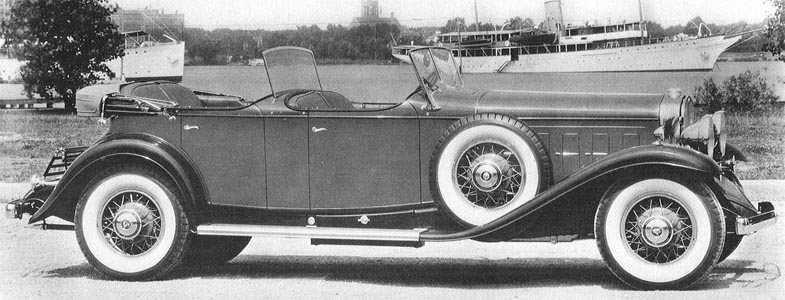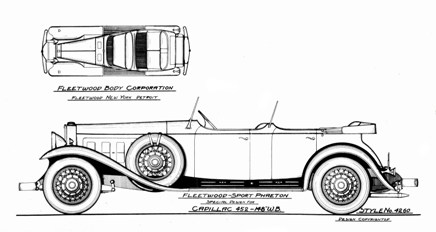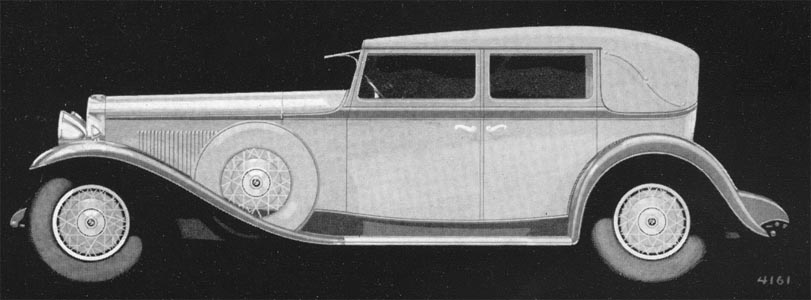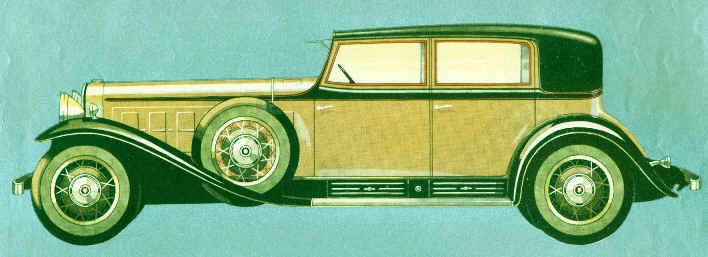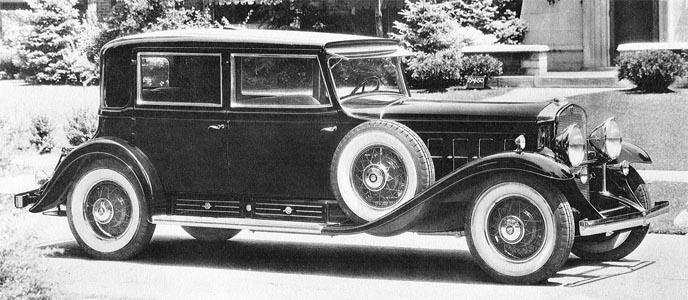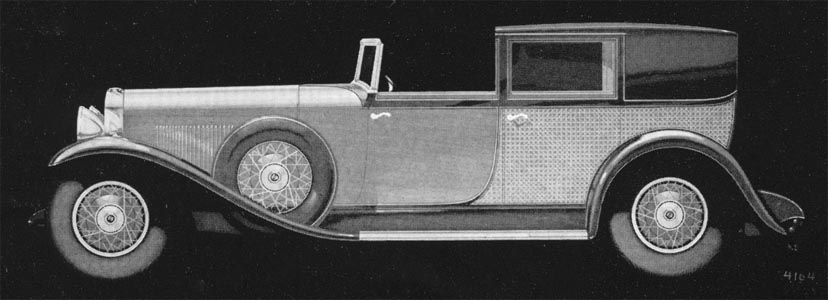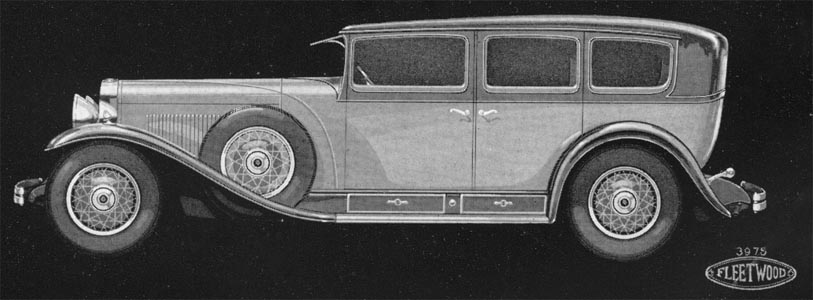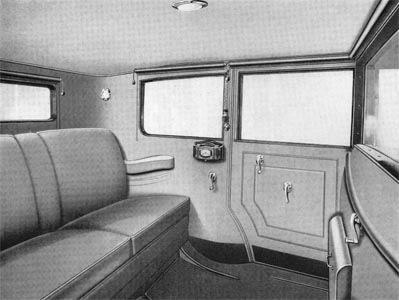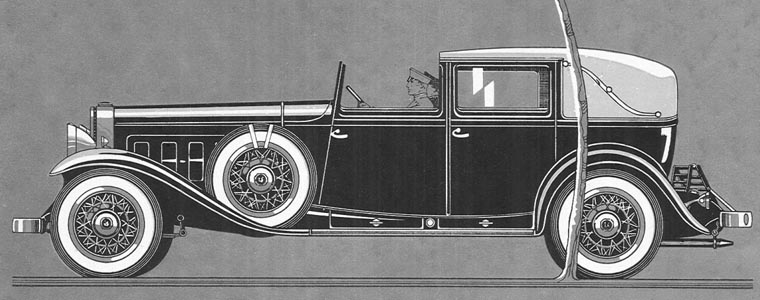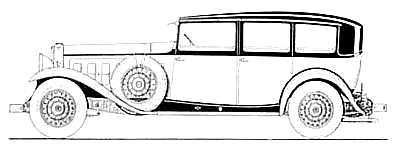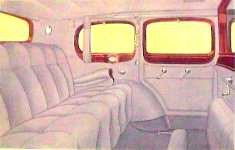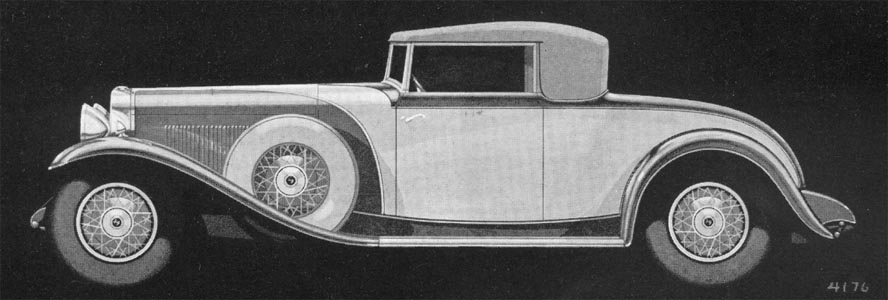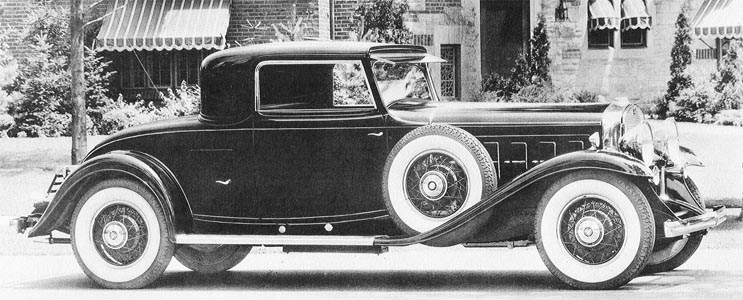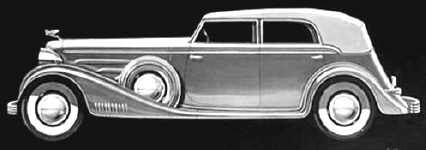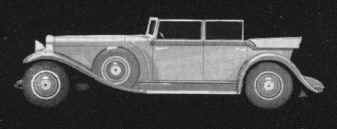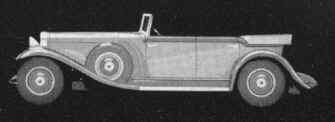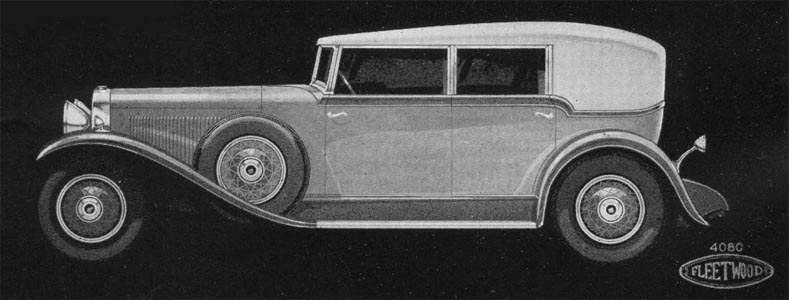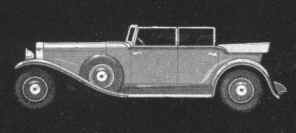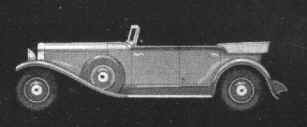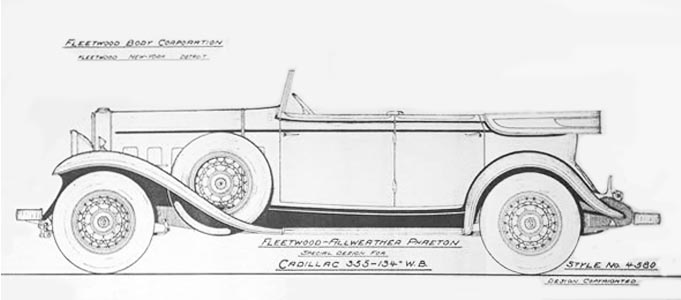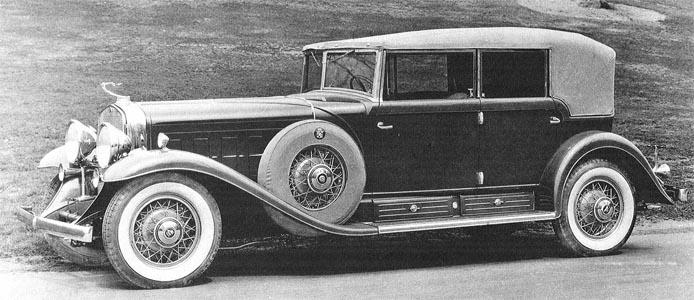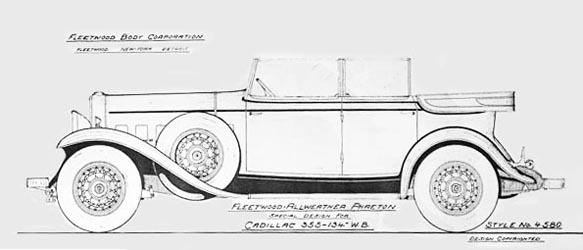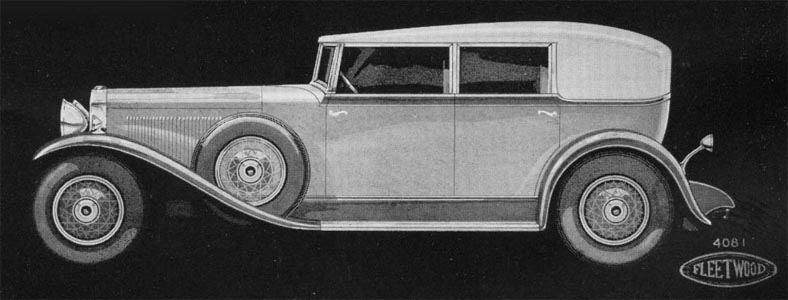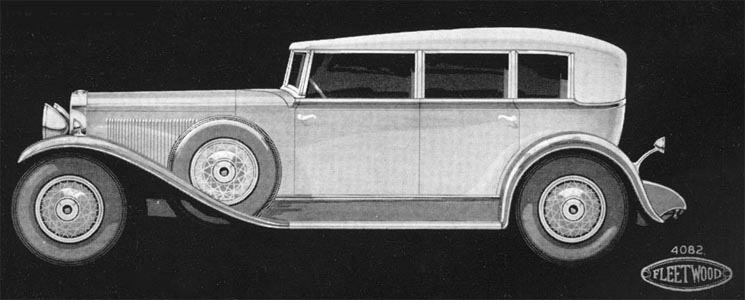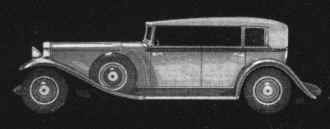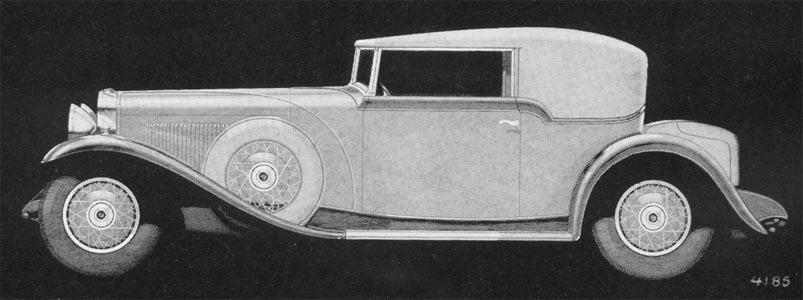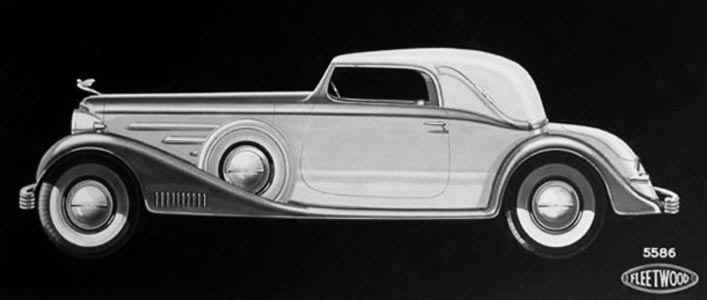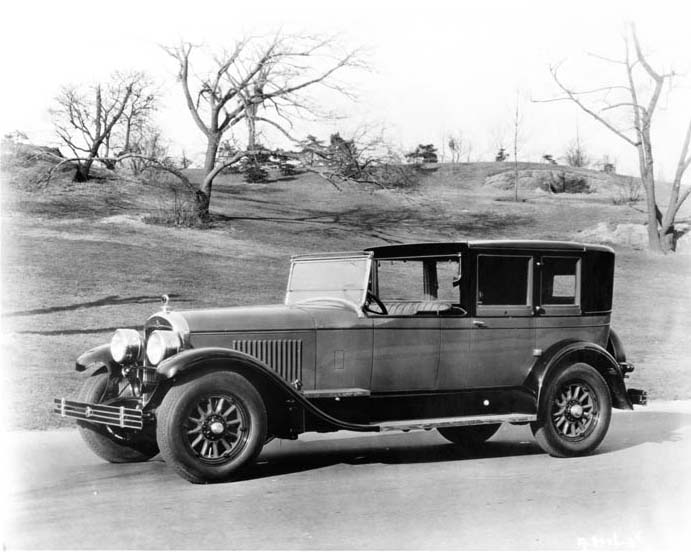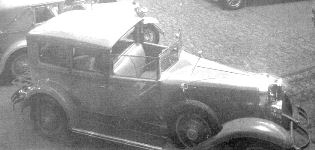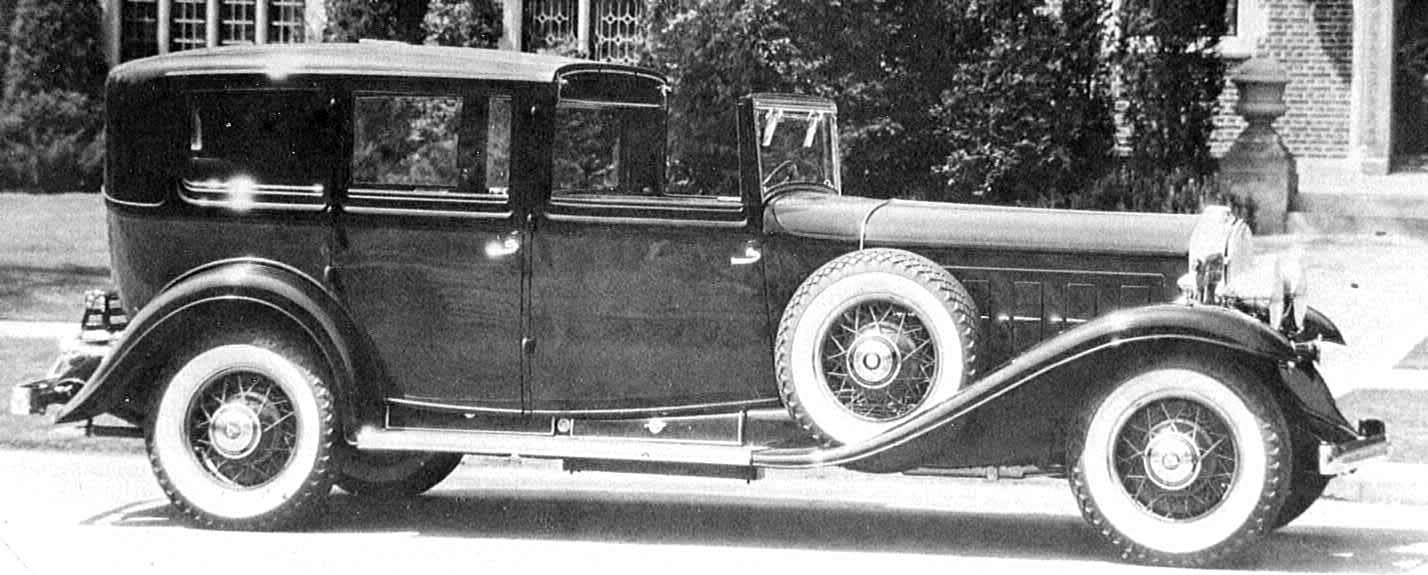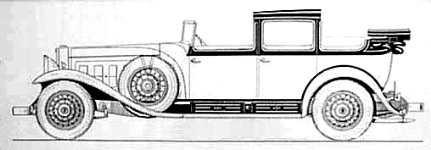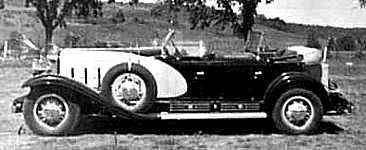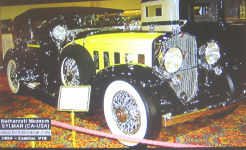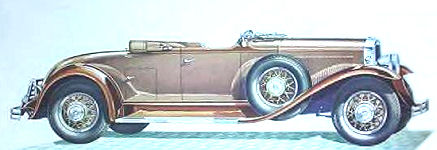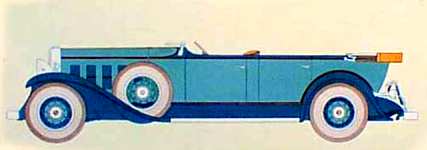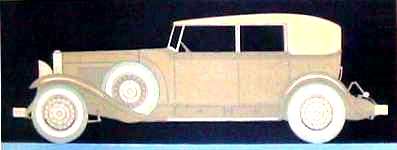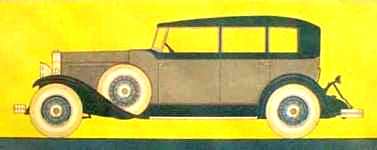| 60 (1) | In 1927 style #3260 was a 5-passenger imperial and style #3260S a 5-passenger sedan. In 1928, style #3360 was a 5-passenger imperial. However, these digits soon were used to identify phaeton and sport phaeton styles. Style #8060 was a 7-pass. standard sedan on Series 303 LaSalle in 1928. |
| 60 (2) | 1930 V-8 style #3960 and La Salle style #4060 Termed the La
Salle Fleetshire phaeton; I have an artist's drawing of another 1930 design,
style #4160 [logically a V-16 style but in this case a V-8],
5-passenger sport phaeton, without secondary cowl [Fleetwood sport phaetons generally all
had a folding dual cowl and secondary windshield that folded forward, flat against the
broad cowl], scalloped hood, front-folding windshield, front opening doors and rear
mounted trunk. Other Fleetwood 5-passenger phaetons offered in 1931
were styles #4560 and #4760.
|
| 60 (3) | 1933 Fleetwood proposal for V-16 (never built), style #5560 dual-cowl sport phaeton. |
| 60A | Style #4160A was a Fleetwood proposal
for the 140" V-8 Cadillac chassis of 1929 and 1930 (the
initial digits "41" later were used for the exclusive, 4-door Madame X
styles on the V-16 chassis); it was a 5-passenger sport
phaeton style but the drawing I have does not show a secondary cowl or windshield.
The "A" suffix usually denotes a departure from the regular design; this style
has a convex rear body curve and a special belt molding (it
might be the reason why V-16 style 4257H, above, frequently is identified as 4257A). The
year 1930 saw also a special sport phaeton on the V-16 chassis identified as style
#4260A; the "A" suffix in this case denoted the presence of the so-called Le
Baron scalloped hood of V-16 styles with initial digits "43"; that
hood precluded the use of a belt molding; in addition, the car had cloth upholstery in a
piped design (cloth is rarely used in convertible cars); the car was one of the official
cars [not the pace car] at the 1930 Indianapolis 500, where it was
driven by Willard Rader, then superintendent of the experimental garage of the Cadillac
Motor Car Co. This unique car was last heard of in 1972 but, like many weird and
wonderful special Cadillacs there is no saying it won't turn up again, out of the blue.
Although the style was offered again in 1933, none were built. BTW, the designer's drawing
I got in 2001 from fellow CLC member and V-16 enthusiast, Craig Watrous, shows an open
phaeton style with a convex curved trunk area and special, raised (?) hood and belt
molding; despite initial digits "42", usually indicating a curved or coach sill,
the designer's drawing features the straight sill of the "43" series
designs.
|
| 60B | Design #4160B, a 5-passenger sport phaeton apparently without
lift-up secondary cowl and folding windshield for rear seat passengers (the initial digits "41" later were used for the exclusive,
4-door Madame X styles on the V-16 chassis). The car had a plain hood and
horizontal belt molding that swept up and over the front cowl behind the flat,
slightly-raked windshield; it had slender windshield posts à la Madame X,
and front opening doors. In this case, I assume that the "B" suffix denotes
the convex rear body and special belt molding.
|
| 60S (1) | Style #3260S, a 5-passenger sedan on 132" wheel base V-8 Cadillac chassis for 1927 and 140" wheel base V-8 chassis for 1928. 1928 also saw a style #3360S, 5-passenger sedan. |
| 60S (2) | The Series Sixty Special model introduced in 1938 became popularly known as the 60S in the post-WW2 period. |
| 61 | Introduced in 1927, style #3261 was a
5-passenger imperial cabriolet, presumably with a division between the chauffeur and rear
seat passenger area; the code was used again in 1928 and 1929; in 1930 it designated style
#4161, a special 5-passenger imperial cabriolet on the V-8 chassis, with plain hood,
straight sill with narrow saddle across cowl in front of windshield, center opening doors,
a "42" series curved or mail coach sill, inward curving rear body
panel, stationary top with light-tan colored leather covering fabric-grained to imitate
Burbank cloth, sun visor
(the initial digits "41" later were used for the
exclusive, 4-door Madame X styles on the V-16 chassis). |
| 61C | The landau roof option was available
also on V-16 style #4161. However, none were built. The designer's drawing I got in
2001 from fellow CLC member and V-16 enthusiast, Craig Watrous, shows this landau style
open.
|
| 61S | In 1927 style #3261S was a 5-passenger
sedan cabriolet; the number was used again in 1930, e.g. V-8 style #3861S, 5-passenger
close-coupled sedan, with full leather back and rear ¼-panels and trunk; it weighed 4850
lbs and cost $4395. Fleetwood built many bodies of this style on the V-16 chassis (Madame X style #4161S priced at $6950 - 43 units, and #4361S priced at $5950 - 258 units). Both styles featured a painted metal roof and rear quarters and an adjustable front seat finished in cloth trim. The cheaper style (#4361S) had a flat, almost vertical Fisher "VV"-type windshield with stubby windshield posts, one ventilator on either side of the cowl, a dome light combined with a roof ventilator, two inner corner lights and two outer step lights for rear doors. Windows in all doors dropped flush with door moldings, hardware was Fleetwood-designed and fully chrome-plated, there were a flush-type vanity case and smoking case in the rear compartment. Int. finish panels were walnut with burl inlay and ebony inlaid stripe on all doors and instrument panel. Concealed pocket in side arm rest was accessed by raising arm rest pad. Other features and fittings including adjustable rear seat and rear seat back, folding center arm rest [rear seat], curtains on all windows in rear compartment, trunk rack and rear trunk. As usual, car was pre-wired for radio, the latter being available at extra cost. Final digits "61S" were used again in 1933 for a similar body type. Only one unit was built.
|
| 61SC (1) | 1930 V-8 style #3861SC, 5-passenger close-coupled landaulet sedan. |
| 61SC (2) | The landau roof option was available also on V-16 style #4161S. However, none were built. The designer's drawing I got in 2001 [slightly modified - text removed] from fellow CLC member and V-16 enthusiast, Craig Watrous, shows this landau style open. In outward appearance, this style was identical to style #4161, illustrated above. |
| 62 | Special V-16 style #4262 (one unit
built); described as a 7-passenger imperial cabriolet, this large limousine presumably did
not have ¼-windows; it was fitted with two wide, forward-facing auxiliary seats and had a
roof covering of English landau leather. At a glance it probably had the same outward
appearance as the Fleetwood V-16 style #4275 limousine (of which only one unit was built),
except that the latter had ¼-windows and no leather roof covering. I have seen no factory
photos of this car (or style #4275 for that matter) but have drawn my own impression of
what it might have looked like (I borrowed the sill from the "42" series V-16s,
applied the body of the style #4375 and blanked off its ¼-windows).
|
| 63 | 1933 Fleetwood proposal, style #5563 (which was never built) was described as a 5-passenger sport imperial. It was to feature the special long hood of other 1933 sports models as well as three large, exposed chrome plated hinges. This car could be likened to style "61" with a built-in trunk. It was to feature a 1933 Fleetwood novelty for enclosed cars: the rear trunk behind a protruding, concave-curved panel. |
| 63S | 1933 Fleetwood proposal, style #5563S (which was never built); this was to be the sedan version of the preceding car, obtained by omitting the partition. |
| 64 (1) | 1930 design #4164 described as a Transformable
metal quarter panel Brougham with a Washington coach or boot toe
molding curving down from the center post and sweeping forward to the straight body sill;
an artist's drawing shows the lower rear body painted with cane work appliqué such
as was seen in the three style #4264B town Broughams built
later in 1930 on the Series 452 V-16 chassis. The designer's
drawing further shows a slightly-raked "V"-type windshield, whereas actual cars
built [style #4264B] had a slightly-raked flat windshield. The car featured a plain hood,
a straight belt molding curving up and over the cowl, ending in a "V" at its
forward edge. Doors were rear opening and the rear body had an inward curve.
|
64 (2) |
1930 V-16 style #4264 (4 units built),
a standard Fleetwood style, was a so-called razor-edged Brougham described in factory
literature as a Transformable town Brougham, i.e. a town car with plain hood,
curved or mail coach sill, flat, slightly raked windshield and rear opening
doors. Other features included a painted metal roof, square corners, no ¼-windows, two
opera-type auxiliary seats, LH facing side, RH facing rear, solid bronze windshield frame
painted to match body, swing-out type with chrome plated inner frames, ventilators each
side of cowl and one on top, two inner corner lights, two outside step lights for rear
doors, glass in front doors, rear doors and division drops flush with moldings, Fleetwood
designed chrome-plated hardware, finish panels on front and rear doors, division panel is
combined panel and smoking set, concealed pocket in side arm rests (access by raising top
pad of arm rest), driver's roof curtain can be folded back with side panels and concealed
in compartment in upper front part of body, telephone in slash pocket on RH ¼-panel above
arm rest, also porthole in division glass, silk curtains on all windows in rear
compartment including division, folding arm rest in center of rear seat back, two arm
slings, slash pocket on RH ¼-panel above arm rest for hand mirror, clock on division
header bar, adjustable rear seat cushion and seat back. This style was offered again in
1933 but was never built; the newer version (style #5564) was to feature a 1933 Fleetwood
novelty for closed-body styles, a concave-curved rear body panel with a door to storage
space behind the rear seat (an early version of today's trunk). Roof could be had with or
without leather.
|
64B |
Six style #4264B town Broughams were
built on the Series 452 V-16 chassis in 1930. The car was similar in appearance
to style #4264 but featured the so-called Washington coach or boot toe
sill below the passenger compartment door. Three of the six cars built featured a painted
canework appliqué on the lower body and rear panel of the passenger compartment;
to quote Walter M. P. McCall: The simulated cane-work was an incredibly time-consuming
project. The 'cane' strips were actually strips of thick paint composition, meticulously
applied by hand, using a small squeeze tube. Despite the immense amount of time needed to
produce a cane-work effect, this method resulted in a far better job than did cementing
real cane-work to the body, as the real cane had a tendency to break loose from the metal
in a relatively short time. Such a car was one of only two V-16s ready in time for the
New York Salon when it opened its doors on 4 January 1930. Appointments of style #4264B
were like those of style #4264. Factory records show that body #2 was shipped to New
York's Astor Hotel [the Waldorf Astoria] on 12.28.1929, together with
the first unit of landaulet style #4108C [see above], presumably for the Show opening. I
have what I assume to be factory or press photos of both styles #4108C [looking like style
#4155C] and #4264B, both sans V-16 medallion on the wheel covers, taken in what
appears to be a vast hotel lounge or ballroom; if any reader recognizes these premises,
please let me know. It should be noted that a car very similar to this one, but with a
longer body and full-sized jump seats, was built by the European coach builder Bronkhorst;
a photo of it appeared in a pre-war French magazine La Carrosserie Automobile
[#92]. Style #4264B was offered again in 1933 but was probably considered somewhat passé as none were built. A friend of mine in Ohio bought in the late Eighties a re-bodies or "replica" style #4264B, that is a conversion from an authentic Fleetwood town car style. I believe the conversion was begun in the seventies by Dave Holtzman, a Michigan resident. The car's first owner was a Mr. O.C. Watts; the current owner [1994] still has the original seat back inserts in petit point said to have been specially ordered by the first owner's wife. Trivia: Scale replica manufacturer, Jo-Han, USA, put out in the sixties a kit of style #4264B town car and even reproduced in 1:25 scale the petit point stitching on the rear seat backs design - I am wondering if petit point seat back inserts were standard in all Fleetwood town cars?
|
| 64Q | Style #4864Q on the 143" wheel base V-12 chassis for
1931; I assume that the suffix "Q" is the abbreviation for quarter
[windows] and that this was a standard razor-edged Brougham design with quarter windows in
lieu of blank rear quarters. A body style similar to this one was built in Holland by the Dutch coach builder, Bronkhorst. It looks like a standard V-16 style #4264B but the body is longer and it has the full jump-seat option. |
| 65 | Style #5065, a 7-passenger limousine style on the 140" wheel base Cadillac V-12 chassis for 1932 and similar style #5565 on the 149" wheel base V-16 chassis for 1933; absence of the "cabriolet" label suggests that this was a formal car without the usual leather roof covering. This style could best be described as a 7-passenger version of style #5531 or as a style #5555 car in which the blank rear quarters of the latter were replaced with large ¼-windows. Its painted or chrome window frames and raked windshield place the V-16 version in the Madame X category. |
| 65S | V-16 style #5565S (1933); this was the proposed sedan version of the preceding car, in which the partition was removed. None were built. |
| 66 | 1933 V-16 proposal #5566; this was described as a 7-passenger limousine; again, absence of the "cabriolet" label indicates that there would have been no leather roof covering. This car was to have more rounded lines than style #5565; it would not have been a Madame X model. The large ¼-windows on this style were to be rounded in the upper rear corner, whereas style #5565 had the reverse curve ( ¼-windows rounded in the lower rear corner). In addition the car would have featured the novel 1933 trunk line for sedans, behind a concave-curved rear body panel. |
| 66S | 1933 V-16 proposal #5566S; this was to be the sedan version of the preceding car, but like it, none were built. |
| 67 | Pre- and post-war styling code digits
designating a 2-door convertible style (e.g. V-16 style #9067 convertible coupe,
1938-1940); in the early thirties, similar body styles carried final digits
"35".
|
| 67D | Style #6267D (1941); Cadillac used the "D" suffix in 1941 to distinguish its De Luxe models from the plainer ones. |
| 69 | Pre- and post-war styling code digits designating a 4-door, 5-passenger sedan (e.g. style #6269, 1942). |
| 69F | Style #6069F (1942); this was a car similar to the above style #6069 but equipped with a glass division. |
